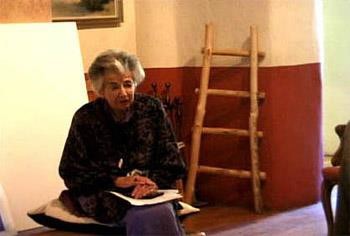History of Tissue Paper Collage Therapy
Creation is not an innocent act! It is the beginning of history and the possibility of evolution. It would be the end of innocence if, from the beginning, this creative process did not happen over and over again. It always starts with innocence, the fool’s road, demanding the courage to take risks, to experiment with the unknown.”
— Dr. Edith Wallace

Wallace began working with tissue paper as an art material in 1970 while in England studying at Sherborne, a school run by J.G. Bennett. She discovered the art mediums she had been using were limited in their scope of expression and thus began working with tissue paper in the form of collage, which was a mirror, in effect, to look more deeply into one’s life. Devoting her life to the search for truth, Wallace went on to evolve her tissue paper collage work into a process engaging participants in image making, storytelling, movement, meditation and reflective group process. She facilitated Tissue Paper Collage Playshops across the U.S., Canada and Europe for many decades.
Recognizing a need to trust the self-regulating function of the psyche—in what Jung called the Self and Wallace referred to as the creative process or the inner guide—she always talked about the tissue paper having a mind of its own. The tissue paper as a medium offers a freedom of expression that the individual is not in control of: images arising from tissue paper collages are somatic representations of inner states of being. Wallace’s intention with this process was to inspire wholeness, integration, and individuation with the intention of a deeper connection to the cosmos.
C.G. Jung’s technique of active imagination was an integral part of her work. In the book Approaches to Art Therapy, Wallace wrote a chapter on active imagination entitled Healing through the Visual Arts¹ . She shared the importance of working with images, stating: “Since the image precedes the word, we can through images (as well as through body movement) evoke unknown aspects of the psyche and bring them to the light of consciousness; this results in understanding and often healing. For healing to take place, however, we must take the consequences of what we have understood and bring our understanding into the reality of lived life. I have chosen one method-that of active imagination-which deals with images and is based on the fact that we must trust such images, which arise from the depth of the psyche. This method presupposes that truth resides in the unconscious-not only on a personal, ego level, but as a profound historical truth-and is manifested in archetypal images arising from the collective unconscious.
The central archetype which Jung called the ‘Self’ is of special importance as a healing factor. It has a regulating, stabilizing function, compensating for any imbalance that might arise. It could also be called one’s inner wisdom and guide; I like to call it the ‘creative source.”
Affiliated with the New York Jung Institute for many years, Wallace lectured on Jungian based theory dealing with transformation, art, and healing. She was on the staff of the Institute for Expressive Analysis, and editor emeritus of the Journal for the Arts in Psychotherapy. Wallace published her first book, A Queen's Quest: Pilgrimage for Individuation in June 1990. Her second book, How It All Began and How It Continued: No End! was published in 2000.


